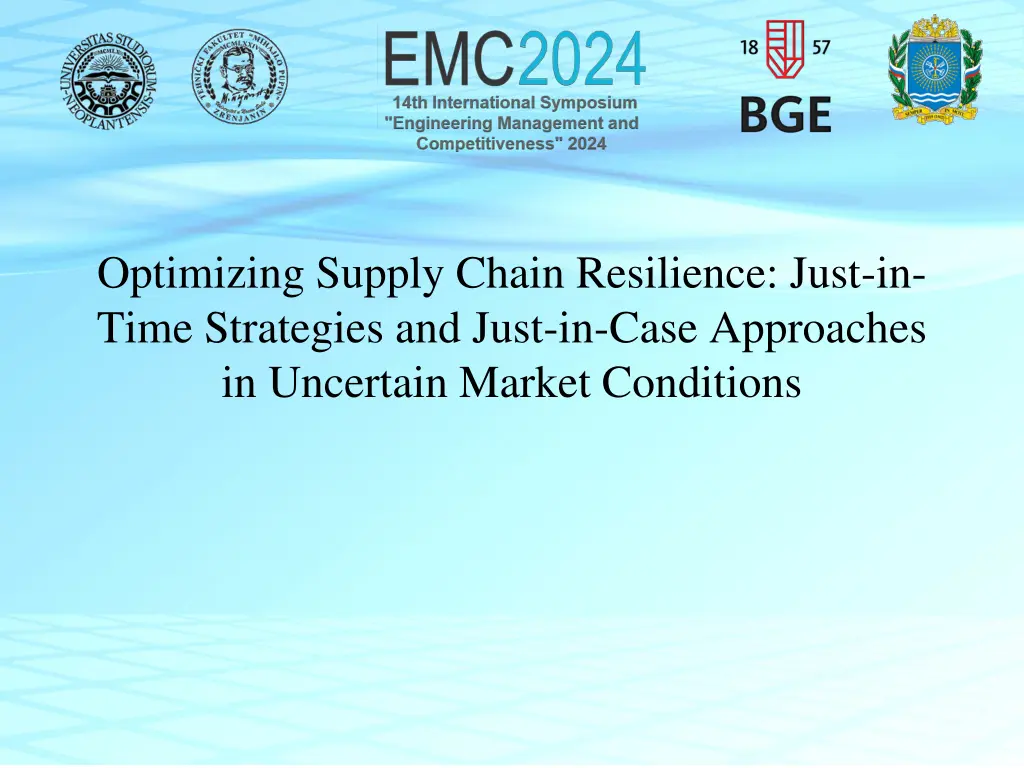
Balancing Efficiency and Resilience in Supply Chain Management
Explore the dynamics of Just-in-Time (JIT) and Just-in-Case (JIC) strategies in supply chain resilience. Learn about the benefits, challenges, and the hybrid inventory strategy that combines the best of both worlds to optimize operational efficiency while safeguarding against disruptions. Discover how businesses can achieve cost savings, improve flexibility, enhance relationships, and mitigate risks for a robust supply chain.
Download Presentation

Please find below an Image/Link to download the presentation.
The content on the website is provided AS IS for your information and personal use only. It may not be sold, licensed, or shared on other websites without obtaining consent from the author. If you encounter any issues during the download, it is possible that the publisher has removed the file from their server.
You are allowed to download the files provided on this website for personal or commercial use, subject to the condition that they are used lawfully. All files are the property of their respective owners.
The content on the website is provided AS IS for your information and personal use only. It may not be sold, licensed, or shared on other websites without obtaining consent from the author.
E N D
Presentation Transcript
Optimizing Supply Chain Resilience: Just-in- Time Strategies and Just-in-Case Approaches in Uncertain Market Conditions
Introduction Just-in-time (JIT) background LEAN concept Just-in-case (JIC) background Importance of supply chain resilience
Basic Just-in-Time model The customer placingan order. The manufacturer receives the order and subsequently necessary materials from the supplier. The supplier receives this order and delivers the required materials or productsto the manufacturer. The manufacturer then assembles the product from materials and fulfills the order. Finally, the customer receives the completed product. This JIT process aims to minimize inventory levels by closely aligning actual demand. process begins with the orders or the products the received production with
Pros of Just-in-Time vs. Just-in-Case JIT Cost Efficiency Waste Reduction Improved Quality and Efficiency Enhanced Supplier Relationships Increased Flexibility Lean Manufacturing JIC Risk Mitigation Ensuring Production Continuity Meeting Demand Fluctuations Managing Lead Time Variability Enhanced Supply Chain Resilience Economic and Geopolitical Stability
Challenges of Just-in-Time and Just-in- Case JIT Supply Chain Disruptions Demand Forecasting Accuracy Supplier Reliability Inventory Management Production Scheduling JIC High Inventory Costs Risk of Obsolescence Inefficiency and Waste Space Requirements Supply Chain Complexity Economic Implications
Hybrid Inventory Strategy A hybrid inventory strategy combines elements of both Just-in-Time (JIT) and Just-in-Case (JIC) inventory management approaches to balance efficiency with resilience. This strategy aims to optimize operational efficiency while ensuring the supply chain can withstand disruptions and fluctuations in demand. A hybrid inventory strategy offers a balanced approach that leverages the strengths of both JIT and JIC methodologies. By combining lean operations with strategic reserves, businesses can optimize efficiency while ensuring resilience against supply chain disruptions and demand variability. This approach enables companies to achieve cost savings, improve flexibility, enhance supplier relationships, and mitigate risks, ultimatelyleading to a more robust and adaptable supply chain.
Guidelines and recommendations Adopt a Balanced Approach - Implement a hybrid strategy that leverages the efficiency of Just-in-Time (JIT) for regular production and the resilience of Just-in-Case (JIC) for critical components. Strengthen Supplier Relationships - Cultivate close, collaborative relationships with key suppliers to ensure reliability and flexibility. Reduce dependency on single suppliers by diversifying your supplier base, including considering nearshoring or regional suppliers to enhance supply chain flexibility. Invest in Technology and Data Analytics - Use predictive analytics and machine learning to improve demand forecasting and adjust inventory levels accurately. Implement real- time data tracking systems, such as IoT and RFID, to monitor inventory levels and supply chain activities continuously. Optimize Inventory Management Processes - Apply JIT principles to routine, high- turnover items to minimize carrying costs and reduce waste. Use JIC principles to keep buffer stock for critical, high-risk components that could disrupt production if unavailable.
Conclusion A hybrid inventory strategy effectively combines the strengths of Just- in-Time (JIT) and Just-in-Case (JIC) methodologies. This balanced approach enhances operational efficiency and supply chain resilience, particularly in uncertain market conditions. By adopting advanced technologies businesses can improve demand management. Strong supplier relationships and diversified sourcing furthermitigaterisks. Regular reviews and continuous improvement ensure the strategy remains effective. Implementing these practices helps companies meet customer demands while maintaining flexibility and preparedness for disruptions. A hybrid inventory strategy ultimately supports sustained business success in a dynamic and uncertain market environment. and forecasting predictive analytics, inventory and
Just-in-time (JIT) JIT ORIGINS - Initially pioneered by Toyota in post-war Japan JIT GOALS - JIT sought to inventory levels by aligning production closely with demand WHY JIT - significantly cut storage costs, improve quality control, and eliminate surplus production minimize
LEAN concept Continuously strive for perfection by relentlessly pursuing the elimination of waste and seeking ways to improve processes. This involves a culture of continuous improvement (Kaizen). Implement a pull-based system where production is based on customer demand rather than forecasting. This overproduction inventory levels. Define what constitutes value from the customer s perspective. This involves understanding what the customer is willing to pay for and ensuring that all activities contribute to this value. minimizes reduces and Map out the entire value stream for each product or service, identifying all the steps in the process and highlighting those that do not add value (waste). Ensure that the production process flows smoothly and continuously interruptions, delays, or bottlenecks. This requires optimizing the sequence of operations and eliminating wasteful steps. without
Just-in-case JIC ORIGINS - approach has been in use since the early days of industrialization. JIC GOALS - ensure business continuity and operational resilience by maintaining a buffer stock of inventory. WHY JIC - maintaining buffer stock, they continue operations during disruptions, meet fluctuating demand, enhance overall supply chain resilience.
